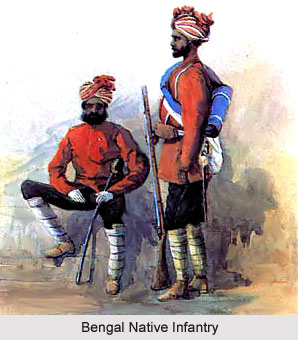 The 25th Regiment of Bengal Native Infantry was a former British Indian infantry regiment. It was formed during the Great Revolt of 1857 and 2 Battalions of the unit were raised. It served till the year 1922. It was incorporated as a part of the Bengal Army, which was the official army of the Bengal Presidency and was one of the Presidency Armies in British India. The infantry regiments of the Bengal army were re-numbered several times during their service. The military unit functioned under the administrative control of British East India Company. Later the British Empire in India took over the management of the 3 British Presidency Armies in British India. The 25th Regiment of Bengal Native Infantry was also known as the 25th Punjabis regiment.
The 25th Regiment of Bengal Native Infantry was a former British Indian infantry regiment. It was formed during the Great Revolt of 1857 and 2 Battalions of the unit were raised. It served till the year 1922. It was incorporated as a part of the Bengal Army, which was the official army of the Bengal Presidency and was one of the Presidency Armies in British India. The infantry regiments of the Bengal army were re-numbered several times during their service. The military unit functioned under the administrative control of British East India Company. Later the British Empire in India took over the management of the 3 British Presidency Armies in British India. The 25th Regiment of Bengal Native Infantry was also known as the 25th Punjabis regiment.
History of 25th Regiment of Bengal Native Infantry
The 25th Regiment of Bengal Native Infantry was raised as the Lahore Punjab Battalion by the British East India Company. The unit was formed on 8 June 1857 at Mian Mir in Lahore by Captain R Larkins during the turmoil of the Sepoy Mutiny. The troops of the unit consisted of Sikhs, Punjabi Muslims and Dogras from other infantry battalions in the British Punjab.
Military Operations of 25th Regiment of Bengal Native Infantry
The regiment was initially engaged in repressing the uprising in various operations in Northern India. Later in the year 1878, the infantry unit participated in the Second Afghan War and fought in the Battle of Kandahar and the Battle of Ahmad Khel. The 25th Punjabis regiment also served in the Relief of Chitral in 1895. Later in 1897, the troops became a part of the Tochi Field Force and provided military service on the North West Indian Frontier during the great tribal uprising.
After the Kitchener reforms in the British Indian Army in the year 1903, the military battalion was renamed as the 25th Punjabis. After the Chinese Revolution in 1911, the 25th Regiment of Bengal Native Infantry was sent to Hong Kong to defend the interests of the British authorities. The troops came back to India during the commencement of the First World War. Subsequently it served Mesopotamia Campaign in December 1917 and became a part of the 54th Brigade, 18th Indian Division. It was then posted in Salonika in Greece in September 1918 and later served as a part of the Allied occupation forces in Turkey.
After the regiment returned to British India in the year 1921, a second battalion was raised on 1 November 1917. It participated in the Third Afghan War in 1919 and was dissolved in 1922.
Development of 25th Regiment of Bengal Native Infantry
After the culmination of World War I, the Indian government restructured the British Indian Army regiments. Most of the single battalion regiments were united to raise larger regiments consisting of four to six battalions. Consequently, the 25th Regiment of Bengal Native Infantry was merged with the 26th Punjabis, 27th Punjabis, 28th Punjabis and 29th Punjabis regiment to form the 15th Punjab Regiment. Later it was re- designated as the 1st Battalion 15th Punjab Regiment. After the Partition of India, the unit was assigned to the Army of Pakistan.
Designations of 25th Regiment of Bengal Native Infantry
The army unit held various titles and designations during it service under the British Indian Army. These are mentioned below -
* The Lahore Punjab Battalion - 1857
* 17th Regiment of Punjab Infantry - 1857
* 29th Regiment of Bengal Native Infantry - 1861
* 25th Regiment of Bengal Native Infantry - 1861
* 25th (Punjab) Regiment of Bengal Native Infantry - 1864
* 25th (Punjab) Regiment of Bengal Infantry - 1885
* 25th Punjab Infantry - 1901
* 25th Punjabis - 1903
* 1st Battalion 25th Punjabis - 1917
* 1st Battalion 15th Punjab Regiment - 1922






































